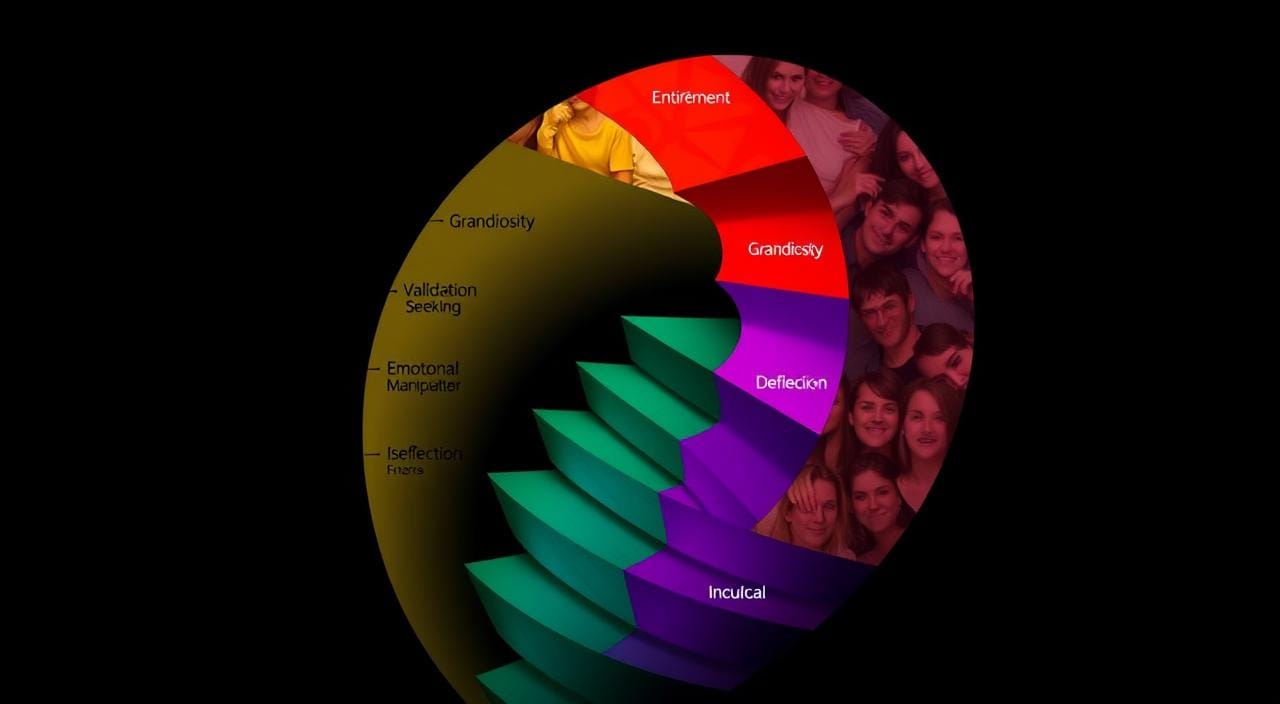Ever wondered what a narcissist thinks when they’re caught lying? Narcissists often lie about everything in their lives1. Their reactions to being caught can be both interesting and disturbing. It’s key to know their patterns and tactics when they’re caught in a lie. So, learn What does a narcissist do when caught lying?
Narcissists lie to protect their fragile self-image. Lying is a big part of who they are, stemming from childhood trauma and unmet needs1. When they’re caught, they might deny, deflect, devalue, or dismiss the issue1.
Key Takeaways
- Narcissists are pathological liars who often lie about everything in their lives.
- Catching a narcissist in a lie is relatively easy, but confronting them is challenging1.
- Narcissists rarely offer honest apologies; any apologies are typically self-serving1.
- Common narcissist lies include making empty promises, shifting blame, and dismissing concerns1.
- Narcissists use the “Four D’s” – deny, deflect, devalue, and dismiss – when caught in a lie1.
The Inescapable Reality of Narcissists and Lies
Narcissists are known to lie a lot, needing to protect their fragile self-worth2. They lie because of childhood trauma and unmet needs2. This makes them unable to be truthful, as they try to control and get what they want.
Narcissists are known for their lying habits and behavior patterns3. They believe their lies, making them seem real to others3. Even when caught, they stick to their story, showing no doubt, wanting to control situations3.
The Power of Projection and Introjection
2 Projection helps narcissists protect their self-image when attacked2. They blame others for their flaws to keep their self-image inflated2. They also use pathological projective identification, projecting their fears onto their victims2.
2 Introjection lets narcissists absorb others’ ideas and behaviors, controlling their victims2. They dominate with their views and invalidate others’ experiences, making their stories the truth2.
| Narcissistic Lying Behavior | Characteristics |
|---|---|
| Pathological Lying | Weaving untruths throughout their lives, causing confusion and doubt3. They believe their lies, making them seem real to others3. |
| Confident Lying | Sticking to their story even when caught, appearing confident3. They want to control situations, believing in their lies3. |
| Deceptive Behavior | They are skilled at eye contact and confidence, making it hard to spot their lies3. Dealing with their lies can be mentally taxing3. |
Narcissists dominate and manipulate, causing emotional harm and trauma2. Understanding their lies and tactics is key to helping victims2.
“Narcissists are skilled at making intense eye contact and maintaining a confident demeanor, making it difficult for others to discern their lies.”
By understanding narcissistic lying and tactics, we can help those affected by abuse23. This knowledge is crucial for healing and recovery23.
What Narcissists Lie About
Narcissists are known for their dishonesty. Research shows they often lie to boost their self-esteem, avoid shame, and control others4. They might promise things they don’t plan to do1 or blame others for their actions1.
Narcissists also use gaslighting to make people question their own sanity1. This keeps them in power and makes them seem superior1.
When caught in a lie, narcissists might deny, deflect, devalue, or dismiss the truth1. This helps protect their ego and avoid being held accountable1.
Narcissists crave constant admiration and attention. Their lies help them achieve this by controlling and manipulating others1. Knowing their common lies is key to spotting and dealing with their toxic behavior1.
| Common Narcissistic Lies | Purpose |
|---|---|
| Making empty promises | To maintain control and manipulate others |
| Refusing to take responsibility | To avoid shame and protect their fragile ego |
| Gaslighting | To make others doubt their own reality and sanity |
Understanding what does a narcissist lie about and common narcissistic lies helps us deal with narcissism14.
The Four D’s: Deny, Deflect, Devalue, Dismiss
Narcissists often use defense mechanisms when their lies are exposed. This pattern, known as the “Four D’s,” is common in those with narcissistic personality disorder5. The Four D’s include denying the truth, deflecting blame, devaluing the accuser, and dismissing the issue entirely.
Denial: A Narcissist’s Reflex
Narcissists struggle to take responsibility for their actions. They often deny the truth, even with strong evidence5. They might gaslight the accuser, saying the incident never happened or that the accuser is wrong5.
Deflecting Blame: The Narcissist’s Favorite Tactic
When caught in a lie, narcissists try to shift the blame5. They blame others, including the person they deceived5. This helps them avoid responsibility and keep their sense of superiority5.
Devaluation: Cutting Down the Accuser
Narcissists try to discredit the person who exposed their lies5. They make the accuser feel small or untrustworthy5. This tactic aims to undermine the accuser’s credibility.
Dismissal: Sweeping It Under the Rug
When all else fails, narcissists might just dismiss the issue5. They act as if the lie never happened or isn’t worth talking about5. This way, they avoid any responsibility or accountability.
Understanding the Four D’s of narcissism is key for victims of narcissists’ lies5. Knowing these defense mechanisms helps you prepare for confronting a narcissist and holding them accountable.

“Narcissists will do anything to avoid taking responsibility for their actions, including denying the truth, deflecting blame, devaluing the accuser, and dismissing the issue entirely.”
| Denial | Deflection | Devaluation | Dismissal |
|---|---|---|---|
| Outright denial of truth, even with evidence5 | Shifting blame onto others, including the victim5 | Attempting to discredit the accuser’s credibility5 | Acting as if the issue is not worth addressing5 |
| Gaslighting the accuser5 | Maintaining a sense of superiority5 | Making the accuser feel small or insignificant5 | Avoiding responsibility and accountability5 |
By understanding narcissists’ tactics when caught in a lie, you can better prepare for these situations5. Recognizing the Four D’s is the first step in exposing the truth and holding narcissists accountable5.
what does a narcissist do when caught lying
When a narcissist is caught lying, they use many tricks to avoid blame. They want to keep their image of being superior6. They might deny, deflect, project, or dismiss the truth6.
Denial means they refuse to admit any wrong, even with clear proof6. They might say they never did or said what they’re accused of. This is to confuse and overwhelm the person accusing them6. Deflection is when they change the subject or blame the accuser6.
Projection is when they blame the accuser for their own lies6. This makes them seem like the victim. Finally, they might just dismiss the whole thing. They get tired and don’t want to talk about it anymore6.
These tricks help narcissists avoid blame and keep their power6. It’s not about making them admit the truth. It’s about spotting their patterns and lies6.
Only a mental health expert can officially say someone has Narcissistic Personality Disorder (NPD)7. But knowing how narcissists act can help you deal with them7.

“Narcissists rarely ever confess, so the goal is not to get them to admit the truth, but to decipher it for yourself by observing their defensive reactions and inconsistencies.”
Exposing the Truth: Strategies for Dealing with Narcissistic Lies
Narcissists are known for their lying8. They use lies to feel important and get admiration8. But, you can fight back and show them the truth.
Popping the Balloon
The “Pinpoint Method” is a strong way to deal with them8. It makes them give specific details, which is hard to keep up with in a lie8. This method can burst their bubble and show their emptiness8.
Deflating the Need for Admiration
The “Create a Vacuum” technique is also effective8. It takes away the attention they crave, making it hard for them to keep up their lies8. This method attacks their need for constant praise, weakening their lies.
Watching their actions, not just their words, can also show their true intentions8. They might make false promises or get angry to hide the truth8. By focusing on their actions, you can see the gap between what they say and do.
Exposing the Emptiness
Even vulnerable narcissists might show some truth when faced with evidence8. But, more cunning ones might get angry or deny everything to keep up their lies8. Keep pushing and you can break through their lies and show their emptiness.
Remember, narcissists think their feelings are facts and will do anything to keep their ego up8. Using these strategies, you can take down their lies and find your own truth.

“The truth will set you free, but first it will piss you off.” – Gloria Steinem
The Neurological Underpinnings of Narcissistic Lying
The study of narcissistic lying is both fascinating and concerning. It shows that lying can change the brain, especially the amygdala, which is the emotional center9. This change makes it easier for people to tell bigger lies over time, as they feel less guilt10.
Narcissists, who see themselves as more important than they really are, don’t worry about getting caught in their lies. Their lies help them keep up their false, grand image9. This can lead to serious problems, especially if they have drug addictions9.
The study of narcissistic lying is complex. It shows that people with Narcissistic Personality Disorder (NPD) might have different brain structures9. They also show more activity in certain brain areas when they lie9.
| Type of Liar | Characteristics | Strategies for Dealing |
|---|---|---|
| Pathetic Liar | Wanting to be liked, avoiding conflict, exaggerating experiences | Considered the least dangerous, with strategies to contain their lies outlined |
| Narcissistic Liar | Demanding attention, denying responsibility, driven by ego rather than logic | Deemed more damaging than pathetic liars, with strategies to manage them detailed |
| Sociopathic Liar | Lying without conscience or remorse, enjoying creating chaos, lacking empathy and moral conscience | Considered the most damaging type of liar, with strategies for dealing with them explained |
The three main types of liars – pathetic, narcissistic, and sociopathic – each pose different challenges11. Pathetic liars are the least dangerous, while narcissistic liars are more harmful. Sociopathic liars are the most dangerous, with possible genetic and childhood neglect factors11.
Ethicists suggest using honesty, rational agency, and humility to confront sociopathic liars. It’s important to document interactions and avoid anger or disappointment11.
Understanding narcissistic lying is key to dealing with this disorder. By knowing the brain changes and the different types of liars, we can find better ways to handle this complex issue91011.
Conclusion
Dealing with a narcissist’s lies can be very frustrating. But, understanding their motives and tactics is key to protecting yourself12. Learning to spot the “Four D’s” and using smart questioning can help you see through their lies12.
It’s important to expose the weakness behind their big ego12. Narcissists often lie about their achievements to seem better12. They use tricks like deflecting and attacking to control others12. Knowing these tricks helps you fight back against their lies.
It’s tough to deal with a narcissist’s lies, but you can get stronger12. Working on yourself and facing personal issues makes you less open to their tricks12. Therapy can help you understand yourself better and fight off their negative effects13. With effort and focus on your well-being, you can overcome their lies and find your truth again.
FAQ
What does a narcissist do when caught lying?
When caught lying, narcissists use the “Four D’s”: deny, deflect, devalue, or dismiss. These actions help them keep control and avoid blame.
What are the common narcissistic lying habits?
Narcissists lie to protect their self-image. This behavior stems from childhood trauma and unmet needs.
What are the typical reactions of a narcissist when their lies are exposed?
Caught in a lie, narcissists deny, blame-shift, gaslight, and minimize. They aim to confuse and keep up their false image.
How does a narcissist react when caught red-handed lying?
Narcissists rarely admit to lying. Instead, they spin stories to confuse and distract. Look for inconsistencies in their words.
How does a narcissist use gaslighting when lying?
Narcissists make you doubt your sanity and perception. They deny allegations, deflect blame, and devalue you.
How do narcissists use blame-shifting when caught in a lie?
Narcissists shift blame to others, including you. They aim to avoid accountability for their dishonesty.
How do narcissists deny their lies?
Narcissists deny all allegations of lying. They insist their version of events is true, refusing to take responsibility.
What kind of “word salad” do narcissists use when lying?
Narcissists create complex stories to confuse and disorient. This tactic is used to overwhelm and distract from the truth.
What are the common lying behavior patterns of narcissists?
Narcissists lie to control, protect their ego, and seek admiration. They lie about everything, even verifiable facts.
What manipulation tactics do narcissists use for lying?
Narcissists deny, deflect, devalue, and dismiss to maintain control. These tactics help them avoid accountability for their lies.
Source Links
- Catching A Narcissist In A Lie (What Happens?) – Thrive Global – https://community.thriveglobal.com/catching-a-narcissist-in-a-lie-what-happens/
- Narcissist Terms – The Ultimate Glossary to DeMystify The Narcissists Power – https://jimmcgeecoaching.com/narcissist-terms-glossary-narcissistic-abuse/
- Love & Lies: 3 Signals Your Partner Might Be a Pathological Liar! – https://ryanhwareborn.medium.com/love-lies-3-signals-your-partner-might-be-a-pathological-liar-0de4519d25ce
- The Difference Between Narcissistic And Benevolent Lies – https://positiveprescription.com/the-difference-between-narcissistic-and-benevolent-lies/
- 5 Toxic Arguing Techniques Narcissists Use – https://psychcentral.com/relationships/narcissist-arguing
- 21 Irresponsible Things a Narcissist Says When You Catch Them in a Lie – https://medium.com/illumination/21-irresponsible-things-a-narcissist-says-when-you-catch-them-in-a-lie-880e7f6050ff
- How to Trick a Narcissist into Telling the Truth: 11 Expert Tips – https://www.wikihow.com/Trick-a-Narcissist-Into-Telling-the-Truth
- How To Get The Truth From a Narcissist – https://unlivingthelie.medium.com/how-to-get-the-truth-from-a-narcissist-44fe241b3e87
- Neurological and Psychological Foundations of Narcissistic Personality Disorder: Impact on Behavior and Addiction – https://juniperpublishers.com/pbsij/pdf/PBSIJ.MS.ID.556076.pdf
- How to catch a Narcopath or Narcissist lying – https://flyingmonkeysdenied.com/2016/12/08/how-to-spot-a-narcissist-lying/
- PR Prose: The 3 types of liars — How to spot and deal with them before they ruin your team – College of Information and Communications – https://sc.edu/study/colleges_schools/cic/journalism_and_mass_communications/news/2018/pr_prose_types_of_liars.php
- How Narcissists Blame and Accuse Others for Their Own Shortcomings – https://psychcentral.com/blog/psychology-self/2019/08/narcissists-blame-projection
- The narcissist’s false reality and how he traps you in it – https://terezashealthblog.wordpress.com/2018/07/05/the-narcissists-false-reality-and-how-he-traps-you-in-it/







